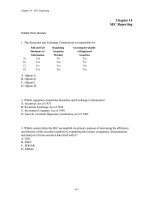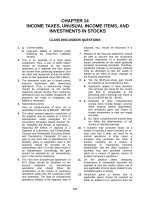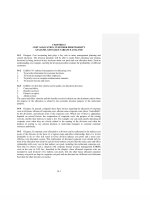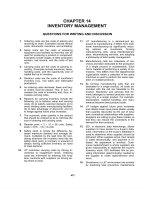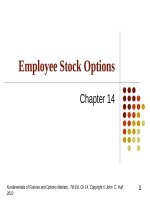Accounting26th ch 14
Bạn đang xem bản rút gọn của tài liệu. Xem và tải ngay bản đầy đủ của tài liệu tại đây (624.53 KB, 30 trang )
CHAPTER
Long-Term Liabilities:
Bonds and Notes
Warren
Reeve
Duchac
©2016
human/iStock/360/Getty Images
Accounting
26e
Financing Corporations
• Corporations finance their operations using the
following sources:
o
o
o
Short-term debt
Long-term debt
Equity
• One of the main factors that influences the decision to
issue debt or equity is the effect that various financing
alternatives will have on earnings per share.
o
Earnings per share (EPS) measures the income earned by
each share of common stock.
Net Income – Preferred Dividends
Earnings per Share =
Number of Common Shares Outstanding
©2016
Bond Characteristics and Terminology
(slide 1 of 2)
•
•
•
A bond is a form of an interest-bearing note. Like a note, a
bond requires periodic interest payments, with the face amount
to be repaid at the maturity date.
The face amount of each bond, called the principal, is usually
$1,000 or a multiple of $1,000. The principal must be repaid
on the dates the bonds mature.
The interest on bonds may be payable annually, semiannually,
or quarterly.
o
•
Most bonds pay interest semiannually.
The underlying contract between the company issuing bonds
and the bondholders is called a bond indenture.
©2016
Bond Characteristics and Terminology
(slide 2 of 2)
• The two most common types of bonds are term bonds
and serial bonds.
o
o
When all bonds of an issue mature at the same time, they
are called term bonds.
If bonds mature over several dates, they are called serial
bonds.
• There are also a variety of more complicated bond
structures.
o
o
Bonds that may be exchanged for other shares of common
stock are called convertible bonds.
Bonds that may be redeemed by the corporation prior to
their maturity are called callable bonds.
©2016
Proceeds from Issuing Bonds
(slide 1 of 3)
• When a corporation issues bonds, the proceeds
received for the bonds depend on:
o
o
o
The face amount of the bonds.
The interest rate on the bonds.
The market rate of interest for similar bonds.
• The price of a bond is quoted as a percentage of the
bond’s face value.
o
o
For example, a $1,000 bond quoted at 98 could be
purchased or sold for $980 ($1,000 × 0.98).
Likewise, bonds quoted at 109 could be purchased or sold
for $1,090 ($1,000 × 1.09).
©2016
Proceeds from Issuing Bonds
(slide 2 of 3)
• The face amount and the interest rate on the bonds
•
•
are identified in the bond indenture.
The interest rate to be paid on the face amount of the
bond is called the contract rate or coupon rate.
The market rate of interest, sometimes called the
effective rate of interest, is the rate determined from
sales and purchases of similar bonds.
©2016
Proceeds from Issuing Bonds
(slide 3 of 3)
• If the market rate equals the contract rate, bonds will
•
•
sell at the face amount.
If the market rate is greater than the contract rate,
the bonds will sell for less than their face value. The
face amount of the bonds less the selling price is
called a discount.
If the market rate is less than the contract rate, the
bonds will sell for more than their face value. The
selling price of the bonds less the face amount is
called a premium.
©2016
Accounting for Bonds Payable
• When bonds are issued at less or more than their face
amount, the discount or premium must be amortized
over the life of the bonds. At the maturity date, the
face amount must be repaid.
©2016
Bonds Issued at Face Amount
(slide 1 of 2)
•
Assume that on January 1, 2015, Eastern Montana
Communications Inc. issued the following bonds:
•
Since the contract rate of interest and the market rate of
interest are the same, the bonds will sell at their face amount.
The entry to record the issuance of the bonds is as follows:
©2016
Bonds Issued at Face Amount
(slide 3 of 3)
•
Every six months (on June 30 and December 31) after the
bonds are issued, interest of $6,000 ($100,000 × 12% × ½
year) is paid. The first interest payment on June 30, 2015, is
recorded as follows:
•
At the maturity date, the payment of the principal of $100,000
is recorded as follows:
©2016
Bonds Issued at a Discount
(slide 1 of 2)
• Assume that on January 1, 2015, Western Wyoming
Distribution Inc. issued the following bonds:
©2016
Bonds Issued at a Discount
(slide 2 of 2)
•
Because the contract rate of interest is less than the market rate
of interest, the bonds will sell at less than their face amount.
Assuming the bonds sell for $96,406, the entry to record the
issuance of the bonds is as follows:
Discount on Bonds Payable is a contra account to Bonds Payable and has a
normal debit balance. It is subtracted from Bonds Payable to determine the
carrying amount (or book value) of the bonds payable. The carrying amount
of bonds payable is the face amount of the bonds less any unamortized
discount or plus any unamortized premium. Thus, the carrying amount of the
bonds payable is $96,406 ($100,000 – $3,594).
©2016
Amortizing a Bond Discount
(slide 1 of 3)
• Every period, a portion of the bond discount must be
reduced and added to interest expense to reflect the
passage of time. This process, called amortization,
increases the contract rate of interest on a bond to the
market rate of interest that existed on the date the
bonds was issued.
©2016
Amortizing a Bond Discount
(slide 2 of 3)
• The entry to amortize a bond discount is as follows:
• The preceding entry may be made annually as an
adjusting entry, or it may be combined with the
semiannual interest payment.
o
In the latter case, the entry would be as follows:
©2016
Amortizing a Bond Discount
(slide 3 of 3)
• The two methods of computing the amortization of a
bond discount are:
o
o
Straight-line method
Effective interest rate method, sometimes called the interest
method
• The effective interest rate method is required by
•
generally accepted accounting principles.
The straight-line method provides equal amounts of
amortization each period and is used in this chapter.
©2016
Bonds Issued at a Premium
(slide 1 of 2)
• Assume that on January 1, 2015, Northern Idaho
Transportation Inc. issued the following bonds:
©2016
Bonds Issued at a Premium
(slide 2 of 2)
•
Because the contract rate of interest is more than the market
rate of interest, the bonds will sell for more than their face
amount. Assuming the bonds sell for $103,769, the entry to
record the issuance of the bonds is as follows:
Premium on Bonds Payable has a normal credit balance. It is added to Bonds
Payable to determine the carrying amount (or book value) of the bonds
payable. Thus, the carrying amount of the bonds payable is $103,769
($100,000 + $3,769).
©2016
Amortizing a Bond Premium
(slide 1 of 2)
• Like bond discounts, a bond premium must be
amortized over the life of the bond. The amortization
of a bond premium decreases the contract rate of
interest on a bond to the market rate of interest that
existed on the date the bonds were issued.
©2016
Amortizing a Bond Premium
(slide 2 of 2)
• The entry to amortize a bond premium is as follows:
• The preceding entry may be made annually as an
adjusting entry, or it may be combined with the
semiannual interest payment.
o
In the latter case, the entry would be as follows:
©2016
Bond Redemption
• A corporation may redeem or call bonds before they
mature.
o
o
o
This is often done when the market rate of interest declines
below the contract rate of interest.
A corporation usually redeems its bonds at a price different
from the carrying amount (or book value) of the bonds.
A gain or loss may be realized on a bond redemption and
are reported in the Other income (loss) section of the income
statement.
• Callable bonds can be redeemed by the issuing
corporation within the period of time and at the price
stated in the bond indenture.
©2016
Installment Notes
• An installment note is a debt that requires the
borrower to make equal periodic payments to the
lender for the term of the note and includes:
o
o
Payment of a portion of the amount initially borrowed,
called the principal
Payment of interest on the outstanding balance
• At the end of the note’s term, the principal will have
•
been repaid in full.
Installment notes are often used to purchase specific
assets, such as equipment, and are often secured by
the purchased asset (called a mortgage note).
©2016
Issuing an Installment Note
• When an installment note is issued, an entry is
•
recorded debiting Cash and crediting Notes Payable.
After the final payment, the carrying amount on the
note is zero, indicating that the note has been paid in
full.
©2016
Amortization of Installment Notes
©2016
Annual Payments
• The entry to record the first payment on December
31, 2015, is as follows:
• The entry to record the final payment on December
31, 2019, is as follows:
©2016
Reporting Long-Term Liabilities
•
Bonds payable and notes payable are reported as liabilities
on the balance sheet.
o
o
•
•
•
Any portion of the bonds or notes that is due within one year is reported
as a current liability.
Any remaining bonds or notes are reported as a long-term liability.
Any unamortized premium is reported as an addition to the
face amount of the bonds.
Any unamortized discount is reported as a deduction from the
face amount of the bonds.
A description of the bonds and notes should also be reported
on the face of the financial statements or in the accompanying
notes.
©2016


